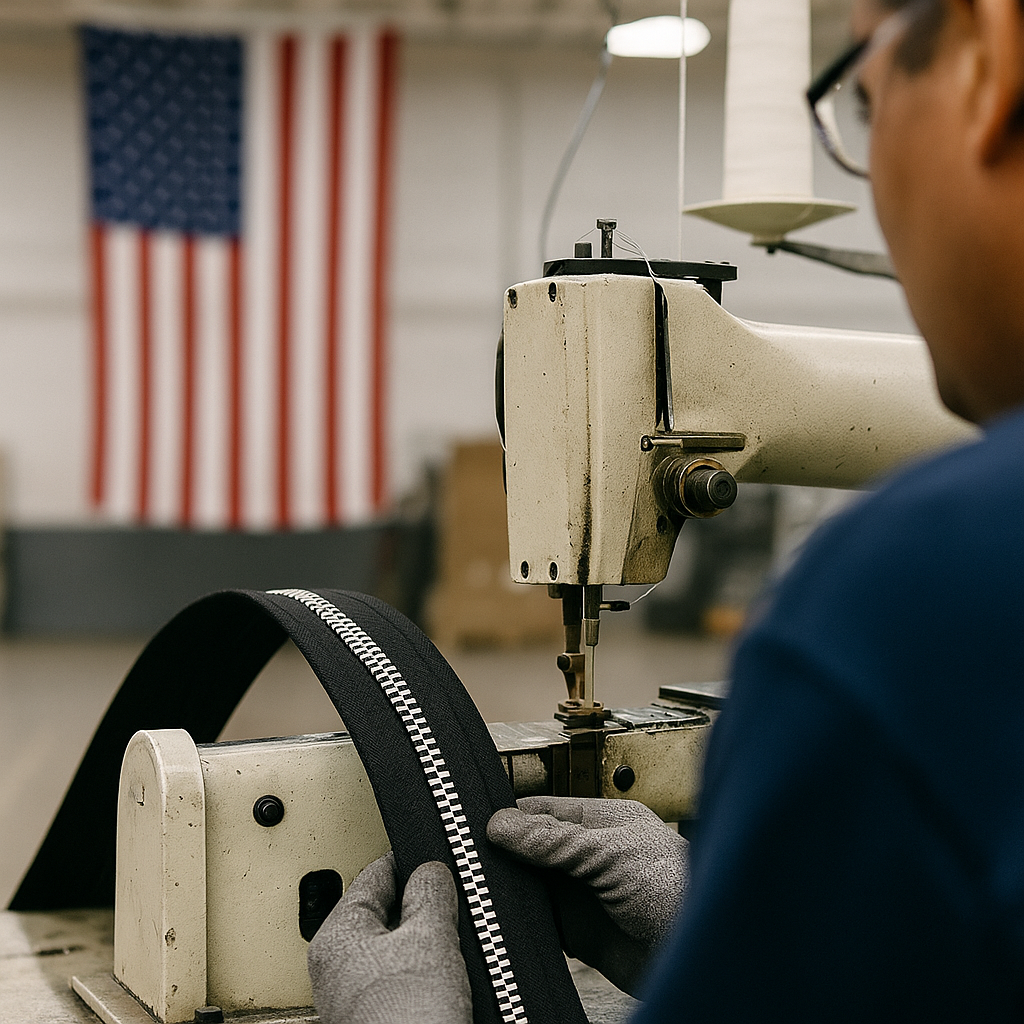The zipper industry is evolving, and today’s OEMs are looking beyond strength and reliability — they’re looking at sustainability. In a global market driven by environmental accountability, materials matter just as much as performance.
For manufacturers, that means sourcing closures that meet ASTM and ISO durability standards and align with ESG, carbon, and recyclability goals. That’s where eco-engineered zippers come in — and LenZip is leading that transformation in the U.S. zipper market.
This article explores how recycled polyester, bio-based nylons, and monomaterial construction are reshaping zipper design. It also explains how LenZip’s engineering teams balance environmental goals with the mechanical precision OEMs expect from a top-tier industrial zipper manufacturer.
What It Means to Engineer a Sustainable Zipper
Eco-engineering begins long before the first tooth is molded or tape woven. It starts at the material formulation stage, with a focus on renewable or recycled feedstocks. Conventional zippers are built from virgin nylon or polyester — polymers derived from petroleum, requiring high energy and producing high carbon emissions.
By contrast, eco-engineered zippers use recycled or renewable inputs that maintain the same molecular structure and performance consistency. These include recycled polyester (rPET), bio-based nylon, and low-emission coatings that replace solvent-heavy finishes with water-based alternatives.
Each of these advances allows a zipper to meet the same ASTM D2061 tensile and ISO fatigue requirements as conventional materials — with dramatically lower environmental impact.

Recycled Polyester: Turning Waste Into Strength
Recycled polyester, or rPET, has quickly become a cornerstone of sustainable textile innovation. Instead of extracting new petroleum, rPET relies on post-consumer plastic bottles, industrial scrap, and reclaimed fibers. These are melted down, purified, and extruded into filament yarns identical in structure to virgin PET.
A single kilogram of rPET diverts roughly thirty plastic bottles from landfill and reduces carbon emissions by up to seventy percent compared to new polyester production. The resulting yarns can be woven into zipper tape, chain, or webbing without retooling any manufacturing machinery.
LenZip incorporates rPET into its Zipper Materials & Finishes collection, offering full transparency on fiber origin, denier, and coating process. Each rPET zipper undergoes ASTM D2061 tensile testing to verify that sustainability never compromises performance.
For OEMs, that means design engineers can specify recycled materials confidently, knowing they will still meet strict mechanical and colorfastness tolerances.
The Role of Bio-Based Nylons
While rPET addresses waste reduction, bio-based nylons focus on fossil fuel substitution. These nylons are derived from renewable plant-based feedstocks, such as castor beans, corn glucose, or sugarcane. Chemically, they replicate the performance of traditional nylon 6 or 6,6 polymers — yet they originate from carbon-neutral or carbon-negative sources.
Bio-nylons exhibit excellent flexibility, chemical resistance, and heat stability, making them suitable for both apparel and technical gear. For instance, castor-bean-derived nylon 11 resists deformation under stress, maintains strength in extreme temperatures, and can pass ISO 12402-7 fatigue testing.
LenZip tests every bio-based nylon zipper under the same ASTM D2061 and ISO fatigue procedures as conventional materials. The results are identical in tensile strength and slider endurance, proving that renewable inputs can match petroleum-based durability benchmarks.
Circular Design and Material Recovery
True sustainability extends beyond sourcing into what happens at the end of a zipper’s life cycle. Most traditional zippers combine multiple materials — metal teeth, polyester tape, and nylon sliders — which complicates recycling.
LenZip’s eco-engineering team addresses that by designing monomaterial zippers, where all primary components share the same polymer family. A zipper made entirely of polyester, for example, can be recycled directly back into polyester resin without disassembly.
This simplifies waste management for large OEMs and supports circular manufacturing loops, where post-industrial scrap can be reprocessed into new zipper feedstock. These closed-loop systems are already operational in LenZip’s Illinois facility, allowing offcuts and rejected prototypes to be reground and reincorporated into future production runs.
The benefit for OEMs is traceable, quantifiable sustainability — real material recovery, not marketing claims.
Energy Efficiency in Manufacturing
Material innovation is only half of the sustainability equation. The other half is production efficiency.
LenZip’s U.S.-based plant operates on renewable electricity contracts and utilizes closed-loop cooling and process-water recovery systems to reduce waste and energy use. Equipment upgrades, including smart drives and optimized heating cycles, have reduced energy consumption by over twenty percent per zipper produced.
Local production eliminates the freight emissions associated with international shipping. For OEMs measuring Scope 3 emissions, these reductions can translate directly into improved sustainability reporting and lower carbon intensity per finished product.
Because all material sourcing, coating, and testing occur under one roof, every LenZip zipper comes with a fully traceable energy and emissions record — a growing requirement for brands adhering to the Global Reporting Initiative (GRI) or CDP disclosure frameworks.

Balancing Sustainability and Performance
A sustainable zipper must perform under the same conditions as a conventional one — UV exposure, salt spray, mechanical stress, and repeated flexing. Performance parity is critical, and LenZip’s engineering process ensures that rPET and bio-nylon meet or exceed all ASTM and ISO benchmarks.
In tensile tests, both recycled and bio-based materials demonstrate equal load-to-failure strength compared to virgin polymers. Accelerated weathering tests following ISO 4892 show no measurable degradation in color or elasticity.
Chemical testing, such as ASTM D543, validates compatibility with solvents, cleaners, and fuels — essential for marine, automotive, and industrial use. The coatings applied through LenZip’s Zipper Coatings and Finishes program further enhance UV and corrosion protection without increasing VOC emissions.
The result is a zipper that performs flawlessly while contributing to a cleaner production cycle.
Sustainable Material Advantages Explained
Recycled polyester offers durability, dimensional stability, and UV resistance equal to virgin PET while using up to seventy percent less energy in production. Bio-based nylon replaces petroleum inputs with renewable crops, maintaining the same tensile properties and adding improved elasticity.
Monomaterial designs simplify post-use recycling by allowing the entire zipper to be processed as one continuous polymer stream. Domestic manufacturing, meanwhile, strengthens supply chain security and cuts down on global shipping-related emissions — a growing priority for OEMs seeking to localize production.
Each innovation contributes to a smaller footprint without compromising the mechanical integrity required for industrial, marine, or outdoor applications.
Testing and Verification of Eco Materials
LenZip’s sustainability claims are backed by data, not assumptions. Every zipper — whether made from rPET, bio-nylon, or traditional polymers — undergoes full ASTM and ISO testing.
Tensile tests following ASTM D2061 confirm chain strength and slider retention. ASTM D543 evaluates chemical compatibility across exposure to oils, detergents, and solvents. Metal or coated components are subjected to ASTM B117 corrosion resistance, while UV and accelerated aging tests follow ISO 4892 and ISO 12402-7.
Each result is recorded and linked to the corresponding production batch, ensuring traceable performance certification. OEM partners receive access to these reports as part of their validation documentation, helping them meet internal QA and sustainability audit requirements.
These verifications provide transparency and credibility — the difference between genuine eco-engineering and surface-level marketing.
Applications in Modern OEM Industries
Sustainable zippers have moved beyond fashion into industrial-grade applications. In outdoor gear, rPET zippers provide the flexibility and fatigue resistance necessary for backpacks and tents, while their low moisture absorption enhances longevity.
Marine fabricators are increasingly adopting bio-nylon chains paired with polyurethane-laminated tapes for high UV exposure and saltwater environments. Medical textile producers choose monomaterial designs that simplify sterilization and recycling within controlled facilities.
Even industrial and chemical protective gear now integrates eco-engineered zippers featuring PTFE or plasma coatings for extreme chemical resistance — proof that environmental responsibility and high performance can coexist seamlessly.
OEM Procurement and Design Considerations
Specifying eco-engineered zippers doesn’t require changing your process — it simply means making smarter material choices. OEM engineers should verify that sustainable materials meet identical testing standards as their existing products. LenZip’s Zipper Testing Standards ensure this parity.
Procurement teams can also request documentation such as GRS certification, life-cycle analysis (LCA) summaries, or feedstock origin reports. These documents help brands demonstrate measurable sustainability improvements to stakeholders and customers.
End-of-life design should also factor into sourcing decisions. Monomaterial designs and fully recyclable coatings reduce downstream waste and align with corporate circularity goals. LenZip provides guidance on integrating these systems into new or existing product lines.
The Advantage of Domestic Eco Manufacturing
Choosing a U.S. manufacturer for sustainable components delivers both environmental and operational benefits. With production centralized in Illinois, LenZip offers shorter lead times, reduced logistics emissions, and lower minimums compared to overseas suppliers.
All materials, coatings, and testing occur in-house under strict ISO 9001 process controls, ensuring consistency and full traceability. Domestic manufacturing also meets U.S. labor and environmental compliance — an essential advantage for government, defense, and institutional contracts under the Berry Amendment.
OEMs gain not only sustainability credentials but also predictable supply, real engineering support, and full documentation for every batch shipped.
Learn More
Sustainability in manufacturing is no longer optional — it’s a standard that forward-thinking OEMs are already embracing. By adopting eco-engineered zippers built from recycled and renewable materials, manufacturers can significantly reduce carbon emissions and strengthen their product life cycles without sacrificing performance or compliance.
LenZip has built its reputation on delivering precision-engineered zippers that last — and now, they last responsibly. Through innovation in materials, coatings, and circular production, LenZip provides OEMs with a sustainable advantage rooted in American manufacturing quality.
Request eco zipper samples or technical specifications at https://lenzip.com/request-a-quote/.
Frequently Asked Questions
- What is the main difference between recycled and bio-based zipper materials?
Recycled materials such as rPET reuse existing plastics, while bio-based nylons are derived from renewable resources like castor beans or sugarcane. Both significantly reduce carbon impact and reliance on fossil fuels. - Do sustainable zippers meet the same strength standards as conventional ones?
Yes. All LenZip eco zippers are tested under ASTM D2061 and ISO 9227 for tensile, fatigue, and corrosion resistance, matching or exceeding the performance of virgin synthetics. - Can these zippers be recycled after use?
Yes. Monomaterial constructions enable complete recyclability since all components share the same polymer base, eliminating separation steps. - How do OEMs verify sustainability claims?
LenZip provides Global Recycled Standard (GRS) certificates, life-cycle analysis data, and energy audit summaries to support ESG compliance. - Are eco zippers available in custom sizes and finishes?
Absolutely. OEMs can specify gauge, tape color, slider design, and coating type through LenZip’s custom program. See Zipper Materials & Finishes for available options.
